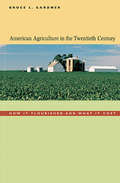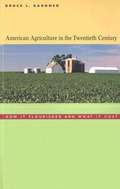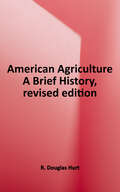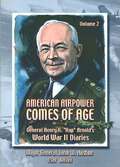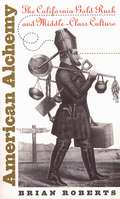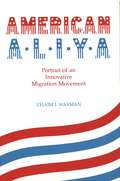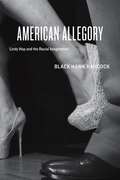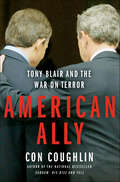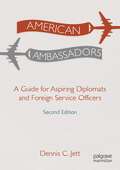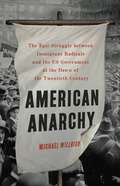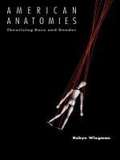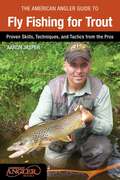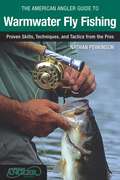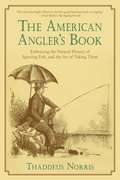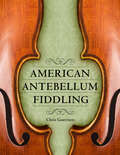- Table View
- List View
American Agriculture in the Twentieth Century: How It Flourished and What It Cost
by Bruce L. GardnerAmerican agriculture in the twentieth century has given the world one of its great success stories, a paradigm of productivity and plenty. Yet the story has its dark side, from the plight of the Okies in the 1930s to the farm crisis of the 1980s to today's concerns about low crop prices and the impact of biotechnology. Looking at U.S. farming over the past century, Bruce Gardner searches out explanations for both the remarkable progress and the persistent social problems that have marked the history of American agriculture. Gardner documents both the economic difficulties that have confronted farmers and the technological and economic transformations that have lifted them from relative poverty to economic parity with the nonfarm population. He provides a detailed analysis of the causes of these trends, with emphasis on the role of government action. He reviews how commodity support programs, driven by interest-group politics, have spent hundreds of billions of dollars to little purpose. Nonetheless, Gardner concludes that by reconciling competing economic interests while fostering productivity growth and economic integration of the farm and nonfarm economies, the overall twentieth-century role of government in American agriculture is fairly viewed as a triumph of democracy.
American Agriculture in theTwentieth Century: How It Flourished and What It Cost
by Bruce L. GardnerAmerican agriculture in the twentieth century has given the world one of its great success stories, a paradigm of productivity and plenty. Yet the story has its dark side, from the plight of the Okies in the 1930s to the farm crisis of the 1980s to today's concerns about low crop prices and the impact of biotechnology. Looking at U. S. farming over the past century, Bruce Gardner searches out explanations for both the remarkable progress and the persistent social problems that have marked the history of American agriculture. Gardner documents both the economic difficulties that have confronted farmers and the technological and economic transformations that have lifted them from relative poverty to economic parity with the nonfarm population. He provides a detailed analysis of the causes of these trends, with emphasis on the role of government action. He reviews how commodity support programs, driven by interest-group politics, have spent hundreds of billions of dollars to little purpose. Nonetheless, Gardner concludes that by reconciling competing economic interests while fostering productivity growth and economic integration of the farm and nonfarm economies, the overall twentieth-century role of government in American agriculture is fairly viewed as a triumph of democracy.
American Agriculture, Water Resources, and Climate Change (National Bureau of Economic Research Conference Report)
by Gary D. Libecap and and Ariel DinarA collection of the most advanced and authoritative agricultural-economic research in the face of increasing water scarcity. Agriculture has been critical in the development of the American economy. Except in parts of the western United States, water access has not been a critical constraint on agricultural productivity, but with climate change, this may no longer be the case. This volume highlights new research on the interconnections between American agriculture, water resources, and climate change. It examines climatic and geologic factors that affect the agricultural sector and highlights historical and contemporary farmer responses to varying conditions and water availability. It identifies the potential effects of climate change on water supplies, access, agricultural practices, and profitability, and analyzes technological, agronomic, management, and institutional adjustments. Adaptations such as new crops, production practices, irrigation technologies, water conveyance infrastructure, fertilizer application, and increased use of groundwater can generate both social benefits and social costs, which may be internalized with various institutional innovations. Drawing on both historical and present experiences, this volume provides valuable insights into the economics of water supply in American agriculture as climate change unfolds.
American Agriculture: A Brief History
by R. Douglas HurtThis book is from the prehistoric period through the twentieth century and is written for anyone coming to this subject for the first time. American Agriculture is a story of considerable achievement and success, but it is also a story of greed, racism, and violence. Hurt offers a provocative look at a history that has been shaped by the best and worst of human nature. Here is the background essential for understanding the complexity of American agricultural history, from the transition to commercial agriculture during the colonial period to the failure of government policy following World War II. Complete with maps, drawings, and over seventy splendid photographs, this revised edition closes with an examination of the troubled landscape at the turn of the twenty-first century. It also provides a ready reference to the economic, social, political, scientific, and technological changes that have most affected farming in America and the contributions of African Americans, Native Americans, and women. This survey will serve as a text for courses in the history of American agriculture and rural studies as well as a supplementary text for economic history and rural sociology courses.
American Airlines in 2011
by Willy ShihThe American Airlines in 2011 case was developed to provide a setting for the comparative analysis of two very different business models in the U.S. domestic airline industry-the network carrier and the low cost carrier (LCC). These models offer very different value propositions. Firms allocate resources into distinctively different processes, and they earn returns using parallel but different profit models. Yet while most scholars view the LCC model as disruptive, the two different models have been able to co-exist for over forty years, albeit with substantial evolution. By unpacking how one of the major network carriers was able to evolve its model successfully for such a long time before industry structural changes necessitated a radical overhaul, the cases seek to give students insights into how the different business models were established, how competitive forces have driven their evolution, and the importance of constantly evolving and tuning a firm's model.
American Airlines' Value Pricing (A)
by Alvin J. Silk Steven C. MichaelIn April 1992, American Airlines launched "Value Pricing" -- a radical simplification of the complex pricing structure that had evolved over more than a decade following deregulation of the U.S. domestic airline industry. American expected that the new pricing structure would benefit consumers and restore profitability to both American and the industry as a whole. The critical issue raised is: Would American's bold initiative work?
American Airlines, Inc.: Revenue Management
by Adam Brandenburger Anirudh DhebarBegins with a description of the elements of post-deregulation competition in the commercial airline industry. This should facilitate a discussion of the use of quantitative methods to support a broad range of tactical and strategic airline decisions. The principal thrust of the case is on revenue management. First, there is a description of the principal pricing concepts, followed by two examples of pricing decisions facing American. Next, there is a discussion of the basic yield management concepts and comments on the challenges in their implementation. Finally, there is a brief write-up on the structure and future of the revenue management organization.
American Airpower Comes Of Age—General Henry H. “Hap” Arnold’s World War II Diaries Vol. I [Illustrated Edition] (General Henry H. “Hap” Arnold’s World War II Diaries #1)
by Maj.-Gen John W. Huston Gen. Henry H. “Hap.” ArnoldIncludes the Aerial Warfare In Europe During World War II illustrations pack with over 180 maps, plans, and photos.Gen Henry H. "Hap." Arnold, US Army Air Forces (AAF) Chief of Staff during World War II, maintained diaries for his several journeys to various meetings and conferences throughout the conflict. Volume 1 introduces Hap Arnold, the setting for five of his journeys, the diaries he kept, and evaluations of those journeys and their consequences. General Arnold's travels brought him into strategy meetings and personal conversations with virtually all leaders of Allied forces as well as many AAF troops around the world. He recorded his impressions, feelings, and expectations in his diaries. Maj Gen John W. Huston, USAF, retired, has captured the essence of Henry H. Hap Arnold--the man, the officer, the AAF chief, and his mission. Volume 2 encompasses General Arnold's final seven journeys and the diaries he kept therein.
American Airpower Comes Of Age—General Henry H. “Hap” Arnold’s World War II Diaries Vol. II [Illustrated Edition] (General Henry H. “Hap” Arnold’s World War II Diaries #2)
by Maj.-Gen John W. Huston Gen. Henry H. “Hap.” ArnoldIncludes the Aerial Warfare In Europe During World War II illustrations pack with over 180 maps, plans, and photos.Gen Henry H. "Hap." Arnold, US Army Air Forces (AAF) Chief of Staff during World War II, maintained diaries for his several journeys to various meetings and conferences throughout the conflict. Volume 1 introduces Hap Arnold, the setting for five of his journeys, the diaries he kept, and evaluations of those journeys and their consequences. General Arnold's travels brought him into strategy meetings and personal conversations with virtually all leaders of Allied forces as well as many AAF troops around the world. He recorded his impressions, feelings, and expectations in his diaries. Maj Gen John W. Huston, USAF, retired, has captured the essence of Henry H. Hap Arnold--the man, the officer, the AAF chief, and his mission. Volume 2 encompasses General Arnold's final seven journeys and the diaries he kept therein.
American Alchemy
by Brian RobertsCalifornia during the gold rush was a place of disputed claims, shoot-outs, gambling halls, and prostitution; a place populated by that rough and rebellious figure, the forty-niner; in short, a place that seems utterly unconnected to middle-class culture. In American Alchemy, however, Brian Roberts offers a surprising challenge to this assumption.Roberts points to a long-neglected truth of the gold rush: many of the northeastern forty-niners who ventured westward were in fact middle-class in origin, status, and values. Tracing the experiences and adventures both of these men and of the "unseen" forty-niners--women who stayed back East while their husbands went out West--he shows that, whatever else the gold seekers abandoned on the road to California, they did not simply turn their backs on middle-class culture.Ultimately, Roberts argues, the story told here reveals an overlooked chapter in the history of the formation of the middle class. While the acquisition of respectability reflects one stage in this history, he says, the gold rush constitutes a second stage--a rebellion against standards of respectability.
American Aliya: Portrait of an Innovative Migration Movement
by Chaim I. WaxmanThe major focus is on the who, when, and where of American immigration to Israel, but it is the "why" of this aliya which constitutes the core of the book. Waxman analyzes the relationship between Zionism, aliya, and the Jewish experience. Chapters include "Zion in Jewish culture," a synopsis of Zionism through the years, and "American Jewry and the land of Israel in the Eighteenth and Nineteenth Centuries," an account of proto-Zionist ideas and movements in early America. Chaim I. Waxman delivers a broad analysis of the phenomenon of American migration to Israel - aliya. Working within the context of the sociology of migration, Waxman provides primary research into a variety of dimensions of this movement and demonstrates the inadequacy of current migration theories to characterize aliya.
American Allegory: Lindy Hop and the Racial Imagination
by Black Hawk HancockOC Perhaps, OCO wrote Ralph Ellison more than seventy years ago, OC the zoot suit contains profound political meaning; perhaps the symmetrical frenzy of the Lindy-hop conceals clues to great potential power. OCO As Ellison noted then, many of our most mundane cultural forms are larger and more important than they appear, taking on great significance and an unexpected depth of meaning. What he saw in the power of the Lindy HopOCothe dance that "Life "magazine once billed as OC AmericaOCOs True National Folk DanceOCOOCowould spread from black America to make a lasting impression on white America and offer us a truly compelling means of understanding our culture. But with what hidden implications? In "American Allegory," Black Hawk Hancock offers an embedded and embodied ethnography that situates dance within a larger Chicago landscape of segregated social practices. Delving into two Chicago dance worlds, the Lindy and SteppinOCO, Hancock uses a combination of participant-observation and interviews to bring to the surface the racial tension that surrounds white use of black cultural forms. Focusing on new forms of appropriation in an era of multiculturalism, Hancock underscores the institutionalization of racial disparities and offers wonderful insights into the intersection of race and culture in America.
American Alligator: Ancient Predator in the Modern World
by Kelby OuchleyHaving survived since the Mesozoic era, alligators teetered on the brink of extinction in the 1960s. Their recovery in the 1970s was largely due to legislative intervention, and today populations are closely monitored throughout their range. American Alligator is the most up-to-date and comprehensive treatment of this resilient relic, a creature with a brain weighing less than half an ounce that has successfully adapted to a changing Earth for more than 200 million years.Kelby Ouchley chronicles the evolution of A. mississippiensis from "shieldcroc"--the last common ancestor of modern-day alligators, crocodiles, caimans, and gavials--to its current role as keystone of the ecological health of America's southern swamps and marshes. In Florida, the apex predator uses its snout and feet to clear muck from holes in the limestone bedrock. During the dry season, these small ponds or "alligator holes" provide refuge, food, and water for a variety of wildlife. In Louisiana, millions of dollars are spent on the bounty of the non-native nutria that overgraze marsh vegetation, but alligators prey on these coastal rodents free of charge.The loss of the American alligator would be a blow to biodiversity and an ecosystem disruption affecting all levels of the food chain. While the U.S. Fish and Wildlife Service removed it from the endangered species list in 1987 and today regulates the legal trade of the animal and its products, Ouchley cautions us not to forget the lessons learned: human activities, from urban development to energy production, can still threaten the future of the gator and its southern wetland habitat.
American Alligators (North American Animals Ser.)
by Steve PottsAmerican alligators live only in North America. Learn all about these big mouthed biters and their habitats in American Alligators.
American Ally: Tony Blair and the War on Terror
by Con CoughlinAmerican Ally is the definitive account of British Prime Minister Tony Blair's support for the United States in the War on Terror. Drawing on his exclusive access to the key players at the White House and Downing Street, Con Coughlin explains what led Blair to risk his political career for a cause that he truly believed in. Just as Bob Woodward called on insiders to analyze George W. Bush in Bush at War, Coughlin now calls on his own experience and sources to offer a critical analysis and account of Tony Blair at war.Here is an in-depth, probing look at the man who has become America's first ally in the post-9/11 world. Tony Blair's staunch support for the United States since 9/11 has confirmed his position as one of the most important and controversial world leaders of the twenty-first century. In the aftermath of terrorist attacks in London and with Iraq in turmoil, the relationship between Britain and the United States will be critical in determining how future international crises are resolved. American Ally is an essential read for those wishing to make an informed opinion.
American Ambassadors
by Dennis C. JettThere are two ways to become an ambassador: a lifetime of dedicated civil service in remote, often life-imperiling locales, or to be a wealthy political benefactor. One route provides grueling work that may never result in this heralded position in the American political landscape, serving some of the world's most challenged nations as they undergo radical change. The other route is considered a gift for financial aid after a successful election campaign. The way in which people become ambassadors of the United States is the result of time-honored traditions and, in some cases, the most thinly veiled form of corruption in American government. American Ambassadors explains where ambassadors come from, what they do, where they go and why they still matter. Former ambassador Dennis Jett offers an insider's look at the complex bureaucratic process that determines who becomes an ambassador and the different paths to the title that are taken by career diplomats and political appointees. Jett describes how an ambassador's effectiveness is measured and why at least four ambassadors in recent years have resigned because of poor performance. It demonstrates how the embassy to which as ambassador is sent can depend on a person's race, gender, religion, sexual orientation and the size of their campaign contributions. And it makes the case for why, in today's ever more globalized world, their work is more important than ever.
American Ambassadors: A Guide for Aspiring Diplomats and Foreign Service Officers
by Dennis C. JettIf you ever wondered who becomes an American ambassador and why, this is the book for you. It describes how Foreign Service officers become ambassadors by rising up through the ranks, and why they typically make up about 70 percent of the total number of ambassadors. It also covers where the other 30 percent come from—the political appointees who get the job because they helped elect the president by supporting him as a campaign contributor, a political ally, or a personal friend. It explains why, despite being illegal and a threat to national security, selling the title of ambassador remains a common practice that is also unique to the United States. It considers why some suggestions for reform are misguided, what might be done, and why who the president is matters so much in determining how well the United States will be represented abroad. This updated and revised edition of Jett's classic book not only provides a timely overview of American ambassadorship for Foreign Service Officers, aspiring diplomats, and interested citizens, but also calls for much-needed reform, describing the dire implications of failing to change our ambassadorial appointments process for the future of American diplomatic practice and foreign policy.
American Amnesia: How the War on Government Led Us to Forget What Made America Prosper
by Jacob S. Hacker Paul PiersonFrom the groundbreaking author team behind the bestselling Winner-Take-All Politics, a timely and topical work that examines what's good for American business and what's good for Americans--and why those interests are misaligned.In Winner-Take-All Politics, Jacob S. Hacker and Paul Pierson explained how political elites have enabled and propelled plutocracy. Now in American Amnesia, they trace the economic and political history of the United States over the last century and show how a viable mixed economy has long been the dominant engine of America's prosperity. Like every other prospering democracy, the United States developed a mixed economy that channeled the spirit of capitalism into strong growth and healthy social development. In this bargain, government and business were as much partners as rivals. Public investments in education, science, transportation, and technology laid the foundation for broadly based prosperity. Programs of economic security and progressive taxation provided a floor of protection and business focused on the pursuit of profit--and government addressed needs business could not. The mixed economy was the most important social innovation of the twentieth century. It spread a previously unimaginable level of broad prosperity. It enabled steep increases in education, health, longevity, and economic security. And yet, extraordinarily, it is anathema to many current economic and political elites. And as the advocates of anti-government free market fundamentalist have gained power, they are hell-bent on scrapping the instrument of nearly a century of unprecedented economic and social progress. In American Amnesia, Hacker and Pierson explain how--and why they must be stopped.
American Anarchy: The Epic Struggle between Immigrant Radicals and the US Government at the Dawn of the Twentieth Century
by Michael WillrichA "lively, fast-paced history" (Adam Hochschild, bestselling author of American Midnight) of America&’s anarchist movement and the government&’s tireless efforts to destroy it In the early twentieth century, anarchists like Emma Goldman and Alexander Berkman championed a radical vision of a world without states, laws, or private property. Militant and sometimes violent, anarchists were heroes to many working-class immigrants. But to many others, anarchism was a terrifyingly foreign ideology. Determined to crush it, government officials launched a decades-long &“war on anarchy,&” a brutal program of spying, censorship, and deportation that set the foundations of the modern surveillance state. The lawyers who came to the anarchists&’ defense advanced groundbreaking arguments for free speech and due process, inspiring the emergence of the civil liberties movement.American Anarchy tells the gripping tale of the anarchists, their allies, and their enemies, showing how their battles over freedom and power still shape our public life.
American Anatomies: Theorizing Race and Gender
by Robyn WiegmanIn this brilliantly combative study, Robyn Wiegman challenges contemporary clichés about race and gender, a formulation that is itself a cliché in need of questioning. As part of what she calls her "feminist disloyalty," she turns a critical, even skeptical, eye on current debates about multiculturalism and "difference" while simultaneously exposing the many ways in which white racial supremacy has been reconfigured since the institutional demise of segregation. Most of all, she examines the hypocrisy and contradictoriness of over a century of narratives that posit Anglo-Americans as heroic agents of racism's decline. Whether assessing Uncle Tom's Cabin, lynching, Leslie Fiedler's racialist mapping of the American novel, the Black Power movement of the 60s, 80s buddy films, or the novels of Richard Wright and Toni Morrison, Wiegman unflinchingly confronts the paradoxes of both racism and antiracist agendas, including those advanced from a feminist perspective.American Anatomies takes the long view: What epistemological frameworks allowed the West, from the Renaissance forward, to schematize racial and gender differences and to create social hierarchies based on these differences? How have those epistemological regimes changed--and not changed--over time? Where are we now? With painstaking care, political passion, and intellectual daring, Wiegman analyzes the biological and cultural bases of racial and gender bias in order to reinvigorate the discussion of identity politics. She concludes that, for very different reasons, identity proves to be dangerous to minority and majority alike.
American Angler Guide to Fly Fishing for Trout: Proven Skills, Techniques, and Tactics from the Pros
by Aaron JasperThe American Angler Guide to Fly Fishing For Trout provides beginning and intermediate anglers with everything they need to know in order to successfully fly fish for the most popular quarry in America. It contains the essentials of casting, the basics of both dry fly fishing and wet fly fishing, a primer on various species of trout, and an overview of prime destinations for planning your trip.There are color photographs as well as line drawings that illustrate casting and knot-tying fundamentals.
American Angler Guide to Warmwater Fly Fishing: Proven Skills, Techniques, and Tactics from the Pros
by Nathan PerkinsonAs warmwater fly fishing grows in popularity, target species such as bass (large- and smallmouth), sunfish, perch, and even carp demand increasingly sophisticated techniques from the modern fly fisherman. The American Angler Guide to Warmwater Fly Fishing offers a quick and succinct look at the essentials of this growing sport. With an array of beautiful photos and instructive illustrations, this guide delivers everything beginning and intermediate anglers need to know about casting technique, gear selection, fly choice, and how best to approach various fish species in their favored habitats. A selection of essential flies and tying recipes rounds out the first essential book for warmwater fly fishermen.
American Angler's Book: Embracing the Natural History of Sporting Fish, and the Art of Taking Them
by Thaddeus NorrisOver one and a half centuries after its original publication, Thaddeus Norris’s The American Angler’s Book remains a classic heavily sought after by fishing enthusiasts and collectors. Considered father of American fly fishing, Norris’s encyclopedic compilation of nineteenth-century tackle and the making of it, information on diverse fish species, and fishing theories and musings was an immensely important tome that helped popularize sport fishing in the United States. Much of the information is still relevant to pursuers of the modern sport. Topics covered include: Hooks, sinkers, swivels, leaders, snoods, lines, rods, and reels Perch, pike, carp, herring, catfish and eels, salmon, and trout species and behaviors Saltwater and fly fishing methods and tackle Repairs, fly-making, and rod-making Fish breeding And more! "Every American Piscator may feel proud [to own]” this "elegant volume” with "beautifully executed” illustrations, proclaimed The New York Times on the book’s original publication. With information copiously gathered and published during the American Civil War, Norris was a leader in his field. Containing a wealth of exquisite engravings, The American Angler’s Book is a must-have addition to any serious fly-fisher’s collection.
American Antebellum Fiddling (American Made Music Series)
by Chris GoertzenThis unique volume is the only book solely about antebellum American fiddling. It includes more than 250 easy-to-read and clearly notated fiddle tunes alongside biographies of fiddlers and careful analysis of their personal tune collections. The reader learns what the tunes of the day were, what the fiddlers’ lives were like, and as much as can be discovered about how fiddling sounded then. Personal histories and tunes’ biographies offer an accessible window on a fascinating period, on decades of growth and change, and on rich cultural history made audible. In the decades before the Civil War, American fiddling thrived mostly in oral tradition, but some fiddlers also wrote down versions of their tunes. This overlap between oral and written traditions reveals much about the sounds and social contexts of fiddling at that time. In the early 1800s, aspiring young violinists maintained manuscript collections of tunes they intended to learn. These books contained notations of oral-tradition dance tunes—many of them melodies that predated and would survive this era—plus plenty of song melodies and marches. Chris Goertzen takes us into the lives and repertoires of two such young men, Arthur McArthur and Philander Seward. Later, in the 1830s to 1850s, music publications grew in size and shrunk in cost, so fewer musicians kept personal manuscript collections. But a pair of energetic musicians did. Goertzen tells the stories of two remarkable violinist/fiddlers who wrote down many hundreds of tunes and whose notations of those tunes are wonderfully detailed, Charles M. Cobb and William Sidney Mount. Goertzen closes by examining particularly problematic collections. He takes a fresh look at George Knauff’s Virginia Reels and presents and analyzes an amateur musician’s own questionable but valuable transcriptions of his grandfather’s fiddling, which reaches back to antebellum western Virginia.
